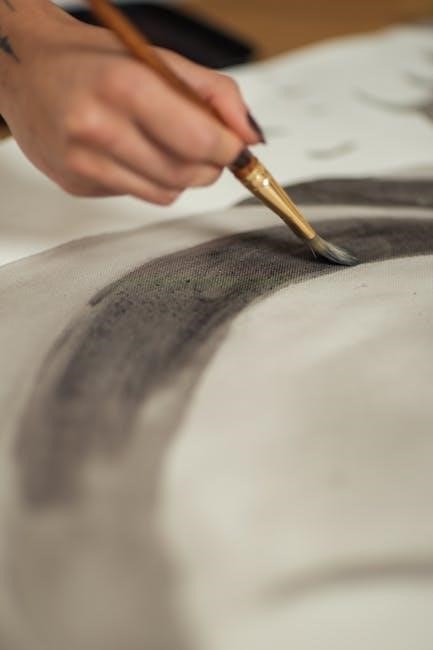boss dd 200 manual
Welcome to the BOSS DD-200 manual! This guide helps you unlock the full potential of your digital delay pedal, featuring advanced effects and customizable settings for enhanced sound creation and performance.
Key Features of the Boss DD-200
The BOSS DD-200 is a powerful digital delay pedal designed for musicians seeking versatility and high-quality sound. It offers 128 user memories for storing custom presets, allowing easy recall of favorite settings. The pedal features 11 delay modes, including standard, analog, tape, and reverse delays, providing a wide range of tonal options. Real-time controls for delay time, feedback, and mix level enable precise adjustments during performances. Additionally, the DD-200 supports MIDI integration, allowing seamless control and synchronization with external devices. Its stereo imaging capabilities enhance spatial depth, making it ideal for both studio and live applications. The pedal also includes a built-in looper for creating layered sounds and phrases. With its robust feature set, the BOSS DD-200 is a versatile tool for guitarists and musicians aiming to expand their creative possibilities.
Target Audience for the Manual
This manual is designed for musicians, producers, and sound engineers who own or plan to use the BOSS DD-200 Digital Delay pedal. It is particularly useful for guitarists seeking to enhance their sound with advanced delay effects. The guide is also beneficial for beginners looking to understand the pedal’s basic operations and experienced users aiming to explore its full potential. Sound engineers and producers will appreciate the detailed instructions for customizing settings and integrating the pedal into studio setups. Additionally, educators and students focusing on music technology can use this manual as a resource for learning about delay effects and their applications. Whether you’re a hobbyist or a professional, this manual provides the information needed to maximize the versatility and functionality of the BOSS DD-200.

Product Overview
The BOSS DD-200 is a versatile digital delay pedal offering advanced features, customizable effects, and high-quality sound processing. Designed for musicians and producers, it delivers exceptional delay capabilities with ease.
Hardware Components of the Boss DD-200
The BOSS DD-200 features a robust metal chassis, ensuring durability for gigging musicians. Its control panel includes delay time, feedback, and level knobs, along with mode and memory navigation buttons. The rear panel offers input/output jacks, MIDI IN/OUT ports for external controllers, and an AC adapter jack. The pedal operates on alkaline batteries or an AC power supply, providing flexibility for different setups. Additional hardware includes rubber feet to prevent floor damage and an external footswitch jack for expanded control options; These components collectively enable versatile and reliable performance, catering to both studio and live environments.
Accessories Included with the Device
The BOSS DD-200 comes with essential accessories to ensure a seamless setup and operation. Included is the Owner’s Manual, which provides detailed instructions for using the pedal effectively. An AC power supply is also provided, allowing you to power the device without relying on batteries. Additionally, the pedal is equipped with rubber feet to protect surfaces from damage. For expanded control, an external footswitch can be connected, offering greater flexibility during live performances. These accessories ensure that you can start using the DD-200 right out of the box, optimizing its functionality and integration into your musical setup.

Installation and Setup
The BOSS DD-200 is easy to set up, with an included AC power supply and optional battery operation. Connect it to your amp or effects loop for immediate use.

Unboxing and Initial Setup
When you unbox the BOSS DD-200, you’ll find the pedal, an owner’s manual, and an AC power supply. Start by reading the manual to understand the device’s features and safety guidelines. Ensure all components are included and in good condition. Place the pedal on a stable surface, using the provided rubber feet to prevent damage to the unit or your floor. Connect the power supply or insert batteries if preferred. Plug in your guitar and amp, then test the pedal to ensure proper operation. Familiarize yourself with the controls and delay modes. The DD-200 is ready to use straight out of the box, with no additional software downloads required for basic operation. Proper setup ensures optimal performance and longevity of the device.
Physical Installation and Placement
Proper physical installation and placement of the BOSS DD-200 ensure optimal performance and durability. Place the pedal on a flat, stable surface, using the provided rubber feet to prevent damage to the device or the floor. Avoid exposing the pedal to extreme temperatures or humidity. For pedalboard use, secure the unit firmly to prevent movement during performances. Ensure the rear panel is easily accessible for connecting cables to inputs, outputs, and external controllers. Position the pedal in a way that minimizes cable interference and maintains a clean setup. If using an AC power supply, keep it away from the pedal to avoid noise interference. Proper placement and installation are crucial for maintaining the DD-200’s functionality and extending its lifespan.
Connecting External Controllers and Footswitches
To enhance the functionality of the BOSS DD-200, you can connect external controllers and footswitches. Use the CTL 1, 2/EXP jack to connect footswitches like the FS-5L or FS-6 for tap tempo, memory selection, and other functions. For advanced control, utilize the MIDI IN and MIDI OUT ports to integrate MIDI controllers, allowing real-time parameter adjustments and synchronization with external devices. When using a footswitch, connect it via a 1/4-inch TRS cable and ensure the switch is configured correctly in the pedal’s settings. For MIDI connections, use standard MIDI cables or USB-MIDI interfaces, depending on your controller. Properly connecting these accessories unlocks expanded creative possibilities and streamlines your workflow during live performances or studio sessions.

Operation Modes
The BOSS DD-200 offers multiple operation modes, including Standard, Reverse, and Warp, each providing unique delay effects. Users can switch modes and adjust settings via real-time controls for dynamic sound shaping.
Understanding Delay Types and Modes
The BOSS DD-200 offers a variety of delay types and modes to cater to different musical needs. The pedal features Standard, Reverse, and Warp modes, each delivering unique delay effects. In Standard mode, you can choose from sub-modes like Analog and Tape, which mimic classic analog and tape-based delays. Reverse mode plays the delay signal backward, creating distinctive, experimental sounds. The Warp mode introduces advanced effects like pitch-shifting and time-stretching for modern, ambient textures. Additionally, the DD-200 allows you to customize delay time, feedback, and level to suit your playing style. By exploring these modes, you can achieve a wide range of tonal possibilities, from subtle echoes to complex soundscapes. This versatility makes the DD-200 a powerful tool for musicians seeking creative delay effects.
Navigating Real-Time Controls and Knobs
The BOSS DD-200 features intuitive real-time controls that allow for seamless adjustment of delay settings. The pedal includes dedicated knobs for Delay Time, Feedback, and Level, enabling precise control over your delay effects. The Delay Time knob sets the duration of the delay, ranging from 0.2ms to 10 seconds. The Feedback knob adjusts the number of repeats, while the Level knob balances the wet/dry signal mix. Additional controls like Tone and Mod allow for further customization of the delay sound. LED indicators provide visual feedback for active settings, making it easy to navigate during performances. These real-time controls ensure that you can tweak your sound on the fly, enhancing your creative expression and versatility in various musical scenarios.

Memory Management
The BOSS DD-200 offers robust memory management with 300 user memories for storing custom presets. Users can easily save, organize, and recall their preferred settings for quick access during performances. The pedal also includes factory presets, providing a solid foundation for creative exploration. Memory management ensures seamless transitions between sounds, making it ideal for live gigs and studio sessions. This feature enhances workflow efficiency and allows musicians to focus on their craft without interruption. The ability to restore factory settings guarantees a clean start whenever needed, maintaining the pedal’s versatility and reliability.
Saving and Organizing Presets
Saving and organizing presets on the BOSS DD-200 is straightforward, allowing users to store up to 300 custom settings. To save a preset, navigate to the desired memory location using the cursor buttons, press and hold the MEMORY/TAP switch, and confirm with the ON/OFF switch. Presets can be organized into banks for easy access during live performances or studio sessions. The pedal also features factory presets, providing a starting point for creative exploration. Users can overwrite factory presets with their own custom settings or restore them later if needed. This feature ensures seamless transitions between sounds and enhances workflow efficiency. By organizing presets effectively, musicians can quickly recall their preferred tones, making the DD-200 a versatile tool for both live and studio applications. This functionality is detailed in the official BOSS DD-200 manual, available for download as a PDF.
Factory Presets and User Memories
The BOSS DD-200 comes equipped with a range of factory presets designed to showcase its versatile delay capabilities. These presets serve as a foundation for exploring various tones and effects, providing users with a starting point for their sound design. In addition to factory presets, the pedal offers 300 user memory locations, allowing for extensive customization and storage of unique settings. Users can overwrite factory presets with their own creations or restore them if desired. This dual approach ensures flexibility, catering to both beginners and experienced musicians. The ability to store and manage multiple user memories makes the DD-200 ideal for live performances and studio work. Detailed instructions on managing these presets can be found in the official BOSS DD-200 manual, available for download as a PDF.
Performing a Factory Reset
To restore the BOSS DD-200 to its original factory settings, follow the outlined procedure in the manual. This process erases all user-customized settings, returning the pedal to its default state. Ensure all important user memories are backed up before proceeding. To perform the reset, hold down the ON/OFF and MEMORY/TAP switches while powering on the device. Release the switches once the factory reset process begins. This action cannot be undone, so proceed with caution. The factory reset is useful for troubleshooting or preparing the unit for resale. Detailed step-by-step instructions are provided in the official BOSS DD-200 manual, available for download as a PDF. Always refer to the manual for precise guidance to avoid unintended data loss.

Advanced Features
The BOSS DD-200 offers advanced effects, customizable settings, and powerful stereo imaging capabilities. It also features MIDI control for seamless integration with external devices and systems.
Customizing Effects and Settings
The BOSS DD-200 allows for extensive customization of effects and settings, enabling users to create unique sounds tailored to their musical needs. With its intuitive interface, you can adjust delay time, feedback, and level parameters to achieve the desired effect. The pedal also features multiple delay types, including standard, analog, tape, and reverse delays, each with its own distinct characteristics. Users can further refine their sound by tweaking wet/dry mix and EQ settings to blend the effect seamlessly with their dry signal. Additionally, the DD-200 supports MIDI integration, allowing for external control and synchronization with other devices. This versatility makes it an ideal choice for both live performances and studio recordings, offering endless possibilities for creative expression and sound experimentation.
Utilizing Stereo Imaging Capabilities

The BOSS DD-200 offers advanced stereo imaging capabilities, allowing you to create immersive and spatially rich soundscapes. With its robust delay engine, you can craft wide, expansive effects that enhance your music’s depth and dimensionality. The pedal features a dedicated Width control, enabling precise adjustment of the stereo field to suit your artistic vision. This feature is particularly useful for creating lush, ambient textures or pinpoint-accurate delay placements in the stereo spectrum. By manipulating the stereo imaging parameters, you can achieve a more engaging and professional sound, making your performances and recordings stand out. This functionality makes the DD-200 an indispensable tool for musicians seeking to elevate their audio quality and creative expression.
MIDI Control and Integration
The BOSS DD-200 supports MIDI control, enabling seamless integration with external devices and systems. This feature allows you to control the pedal’s functions via MIDI messages, such as program changes, control changes, and clock signals. By connecting the DD-200 to a MIDI interface or controller, you can synchronize delay effects with your performance or studio setup. The pedal can also send and receive MIDI data, making it compatible with sequencers, drum machines, and other MIDI-capable gear. This integration enhances your creative workflow, enabling real-time adjustments and precise synchronization. For advanced users, MIDI control opens up possibilities for dynamic live performances and studio recordings, ensuring the DD-200 adapts to any musical environment. Proper setup requires enabling MIDI send/receive and assigning MIDI channels, as detailed in the manual.

Troubleshooting and Maintenance
Identify common issues like connectivity problems or distorted sound and resolve them with the manual’s troubleshooting guide. Regularly clean the pedal and check connections for optimal performance.
Common Issues and Solutions
Experiencing distorted sound? Check your input levels and ensure they are not exceeding the pedal’s capacity. For connectivity issues, verify all cables are securely connected and free from damage. If the footswitch isn’t responding, clean the switch contacts and ensure proper power supply. Firmware updates can often resolve unexpected behaviors, so regularly check the BOSS website for the latest versions. If the pedal fails to power on, test with a fresh set of batteries or an alternate power source. For persistent problems, consult the manual or contact BOSS support for assistance. Proper maintenance, such as cleaning the device and verifying connections, ensures optimal performance and longevity of your DD-200.
Maintenance Tips for Optimal Performance
- Regular Cleaning: Use a soft cloth to wipe down the pedal’s exterior and controls, removing dust and grime that may interfere with functionality.
- Moisture Protection: Keep the DD-200 in a dry environment to prevent damage from humidity or water exposure.
- Cable Management: Inspect all cables for wear and tear, and replace any damaged ones to ensure reliable connections.
- Firmware Updates: Periodically check the BOSS website for firmware updates to maintain peak performance and access new features.
- Power Supply Care: Use high-quality batteries or a stable AC adapter to avoid power-related issues.
- Storage: When not in use, store the pedal in a protective case to prevent scratches or damage.
Restoring Default Settings
To restore the BOSS DD-200 to its factory settings, follow these steps:
- Ensure the pedal is powered on.
- Hold down the ON/OFF switch and MEMORY/TAP switch simultaneously.
- While holding these buttons, turn on the pedal;
- Release the buttons when the display indicates the factory reset process has begun.
- Wait for the pedal to complete the reset and return to its default state.
The pedal will now function as it did when first purchased, with all factory settings intact.

Additional Resources
Explore official support, community forums, and third-party guides for comprehensive assistance and troubleshooting.
- Visit the official BOSS website for downloads and updates.
- Join community forums for user discussions and tips.
- Check third-party tutorials for detailed explanations and tricks.
Official Boss Support and Downloads
The official BOSS website provides comprehensive support for the DD-200, including downloadable resources. Visit the support section to access the DD-200 Owners Manual in multiple languages, ensuring you have detailed instructions for optimal use. Additionally, find software updates, drivers, and firmware enhancements to keep your device up-to-date. The website also offers troubleshooting guides and technical specifications, addressing common issues and maintenance tips. For direct assistance, explore the BOSS support page, where you can submit inquiries or find FAQs. All resources are available for free download, making it easy to maintain and enhance your DD-200 experience.
Community Forums and User Groups
Community forums and user groups dedicated to the BOSS DD-200 are invaluable resources for musicians and producers. These platforms allow users to share experiences, tips, and tricks for maximizing the pedal’s capabilities. Many forums feature discussions on troubleshooting common issues, creative sound design, and custom preset sharing. Users often upload their own patches and settings, fostering a collaborative environment. Additionally, these groups often host tutorials, gear reviews, and live Q&A sessions with experienced musicians and engineers. Third-party platforms like Reddit, Facebook groups, and specialized music gear forums are popular hubs for DD-200 enthusiasts. Engaging with these communities provides access to user-generated content, feedback, and inspiration, helping you get the most out of your digital delay pedal while staying connected to a passionate user base.
Third-Party Tutorials and Guides
Third-party tutorials and guides for the BOSS DD-200 are widely available online, offering in-depth insights and practical examples for mastering the pedal. YouTube channels and music gear websites often feature video tutorials that demonstrate how to optimize delay effects, customize presets, and integrate the pedal into live performances. Additionally, websites like GuitarWorld and MusicRadar provide step-by-step guides for advanced techniques such as stereo imaging and MIDI control. These resources are particularly useful for users looking to explore creative sound design beyond the manual’s instructions. Many forums and communities also share user-generated guides and patches, allowing musicians to learn from peers and expand their sonic possibilities. These third-party resources complement the official manual, offering real-world applications and troubleshooting tips from experienced users.